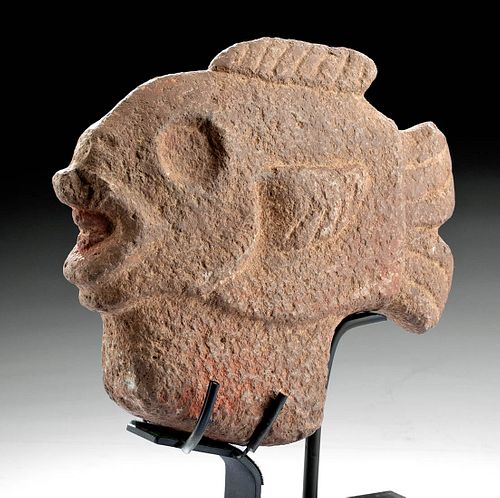Rare / Fine Maya Stone Hacha - Fish Form
Lot 104e
About Seller
Artemis Gallery
686 S Taylor Ave, Ste 106
Louisville, CO 80027
United States
Selling antiquities, ancient and ethnographic art online since 1993, Artemis Gallery specializes in Classical Antiquities (Egyptian, Greek, Roman, Near Eastern), Asian, Pre-Columbian, African / Tribal / Oceanographic art. Our extensive inventory includes pottery, stone, metal, wood, glass and textil...Read more
Estimate:
$10,000 - $15,000
Absentee vs Live bid
Two ways to bid:
- Leave a max absentee bid and the platform will bid on your behalf up to your maximum bid during the live auction.
- Bid live during the auction and your bids will be submitted real-time to the auctioneer.
Bid Increments
| Price | Bid Increment |
|---|---|
| $0 | $25 |
| $300 | $50 |
| $1,000 | $100 |
| $2,000 | $250 |
| $5,000 | $500 |
| $10,000 | $1,000 |
| $20,000 | $2,500 |
| $50,000 | $5,000 |
| $100,000 | $10,000 |
| $200,000 | $20,000 |
About Auction
By Artemis Gallery
Feb 13, 2020
Set Reminder
2020-02-13 10:00:00
2020-02-13 10:00:00
America/New_York
Bidsquare
Bidsquare : Exceptional Antiquities, Asian, Ethnographic
https://www.bidsquare.com/auctions/artemis-gallery/exceptional-antiquities-asian-ethnographic-4848
An important one-day auction featuring museum-worthy examples of Egyptian, Greek, Roman, Etruscan, Near Eastern, Far East / Asian, Pre-Columbian, African / Tribal, Oceanic, Native American, Spanish Colonial, Russian, Fossils, Ancient Jewelry, Fine Art, so much more! Artemis Gallery info@artemisgallery.com
An important one-day auction featuring museum-worthy examples of Egyptian, Greek, Roman, Etruscan, Near Eastern, Far East / Asian, Pre-Columbian, African / Tribal, Oceanic, Native American, Spanish Colonial, Russian, Fossils, Ancient Jewelry, Fine Art, so much more! Artemis Gallery info@artemisgallery.com
- Lot Description
Pre-Columbian, Southern Mexico to Guatemala, Maya, Late Classic Period, ca. 550 to 900 CE. A rare example of a zoomorphic, fish-shaped hacha. It is hewn from a large piece of grey volcanic rock, most likely basalt, and was part of the ritual items associated with the Mesoamerican ballgame. The stone is of a generally flat form in order to resemble a symbolic axe - hence the name "hacha," meaning "axe" in Spanish - and resembles in profile the body of a fish, skillfully carved and pecked on both sides with bold features in positive and negative relief including a circular eye with a sunken center, a wide open mouth with thick lips and oddly human-looking teeth, and fins on the top, tail, and sides. Cinnabar pigment spread over the stone gives it a warm red color. Size: 7.45" W x 6.5" H (18.9 cm x 16.5 cm); 8.75" H (22.2 cm) on included custom stand.
The Mesoamerican ballgame was a ritual event, not just for entertainment (although it would have been that too!), and as a result involved elaborate attire and accessories. Stone hachas were not actually used to play the game, but instead were probably worn or carried, hafted onto wooden poles like standards, in ritual processions where the elite sponsors of the game displayed them to demonstrate their wealth - similar in this respect to seeing the owners of your local team out on the field after a championship win or on Opening Day.
Provenance: ex-private Florida, USA physician’s collection, acquired in 2000; ex-Major Elmer McBride collection, acquired in 1947
All items legal to buy/sell under U.S. Statute covering cultural patrimony Code 2600, CHAPTER 14, and are guaranteed to be as described or your money back.
A Certificate of Authenticity will accompany all winning bids.
We ship worldwide and handle all shipping in-house for your convenience.
#153080Small loss to upper lip on one side; otherwise in great condition with wear commensurate with age and light deposits. Nice preservation of form, detail, and pigment.Condition
- Shipping Info
-
All shipping is handled in-house for your convenience. Your invoice from Artemis Gallery will include shipping calculation instructions. If in doubt, please inquire BEFORE bidding for estimated shipping costs for individual items.
-
- Buyer's Premium



 EUR
EUR CAD
CAD AUD
AUD GBP
GBP MXN
MXN HKD
HKD CNY
CNY MYR
MYR SEK
SEK SGD
SGD CHF
CHF THB
THB














